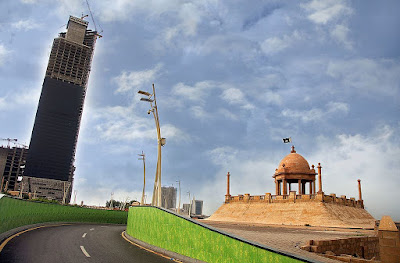KARACHI : The City Of Lights
Karachi is the largest city, main seaport and the financial capital of Pakistan, and the capital of the province of Sindh. With a city population of approximately 18.5 million, Karachi is one of the world's largest cities in terms of population, the 4th largest metropolitan area in the world,and the 2nd largest city within the Organisation of the Islamic Conference. It is Pakistan's premier centre of banking, industry, and trade. Karachi is home to Pakistan's largest corporations, including those that are involved in textiles, shipping, automotive industry, entertainment, the arts, fashion, advertising, publishing, software development and medical research. The city is a major hub of higher education in South Asia and the wider Islamic world. Karachi is ranked as a Beta world city.
Karachi city is almost five times bigger than Singapore. It is locally known as the "City of Lights" and the "City of the Quaid" having been the birth and burial place of Quaid-e-Azam (Muhammad Ali Jinnah), the founder of Pakistan, who made the city his home after Pakistan's independence.

Garbage situation of Karachi is getting from bad to worse, day by day Open sewerage drains and garbage dumbs are giving rise to many harmful diseases. Karachi is the economic hub of Pakistan but still there is no one to look after this city.
Citizens of Karachi do not need to read about city’s sanitation situation in newspaper, they witness it in every street corner of the city.There is no administration at all and because of this, citizens are really frustrated and they need some solution for this problem. Karachi needs some serious attention and it is also a matter of great concern for higher authorities. Sindh government should look into the matter and take some proper steps to make Karachi clean and beautiful.
For visitors, beaches and shopping centers hold the much attraction. The tomb of Quaid e Azam is the hallmark of the Karachi city and is one of the most visited areas in Pakistan. Karachi was in real discovered by the British, it was basically a fishing village called Kolachi. Because of its proximity to the sea, it was preferred and acknowledged by the British. Unlike Lahore, there are not many relics and remnants of Mughal period here, but many specimens of British and Parsi architectural designs are found here.
The most popular ones are following:
1. The Empress tower
The Empress Market is a marketplace situated in the Saddar Town. The market traces its origins to the British Raj era, when it was first constructed. Today, it is amongst the most popular and busy places for shopping in Karachi and reflects as one of the few historical spots of the city. Commodities sold in the Empress Market range from condiments, fruit, vegetables and meat to stationery material, textiles and pets.
Jehangir Kothari Parade is a waterfront elevated sandstone public walkway built on land bequeathed or donated by Seth Jehangir Hormusji Kothari to the city of Karachi back in 1919.
It is situated on a hilltop in the Clifton area of the city famous for its Seaview Beach on the arabian sea which was built in 1919 and opened to Karachi public in 1920. There are two structures: the Promenade Pavilion and the Pier of the complex (elevated sandstone public walkway) which is named after Lady Lloyd, wife of then Governor on that time.
3.The Frere Hall.
Frere Hall is a building in Karachi, Pakistan that dates from the early British colonial-era in Sindh. Completed in 1865, Frere Hall was originally intended to serve as Karachi's town hall, and now serves as an exhibition space and library. It is considered one of Karachi's most iconic buildings.
The Tower stands on a base of 44 feet square and rises to a height of 102 feet. Strachan designed the tower in the Gothic Revival style popular in Victorian England, the architecture of Medieval England (11th to 15th century A.D.). The structure is built in buff colored Gizri stone and shows a heightened sensitivity to detailing and emphasis on carving and decoration. The architecture takes the form of an Eleanor cross.






No comments:
Post a Comment